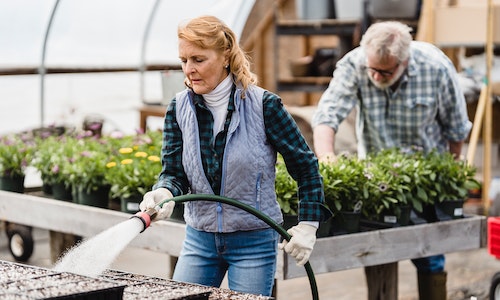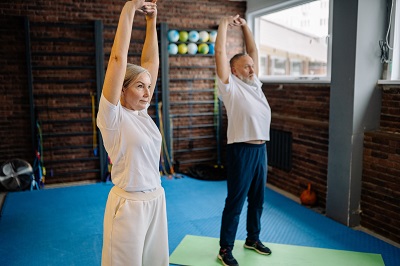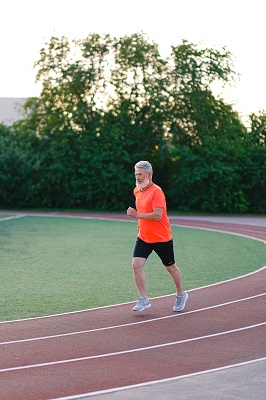Contents
A regular exercise routine is a challenge for everyone. Exercises for Senior Citizens seem to be more difficult. Health problems, aches, and thoughts of injuries discourage you even more from going for a regular exercise routine. If you have exercised before, you might think you are too weak or old to begin again and think that you cannot live up to the standards you set at your young age. If you have not exercised before, you might doubt where to begin.
If you have good reasons to believe that exercise is not for you, remember that there are far better reasons to get active as you age.
Benefits of exercises for senior citizens
Regular exercise will uplift your mood. It will relieve stress, help you manage illness and develop your overall sense of well-being.
Physical health benefits of exercises for senior citizens
Exercises can help you to:
- Maintain or lose weight. Metabolism slows down with age. Therefore, it is a challenge to maintain or lose body weight. Regular exercise will improve your metabolism. It, in turn, helps you build muscle mass and burn more calories. It, in turn, prevents obesity.
- Older adults who exercise regularly have better digestive functioning.
- Regular exercise reduces the impact of chronic diseases and illnesses.
- It improves your blood pressure.
- Regular exercise can provide a lower risk of osteoporosis and improve your bone density.
- Reduces the risk of diabetes.
- Controls the chances of heart diseases.
- Regular exercises for the elderly lower the risk of Alzheimer’s disease and certain cancers.
- Older people who exercise regularly will improve their mobility, flexibility, and balance.
- Exercise improves strength, flexibility, and posture, which helps with coordination. It also reduces your risk of falls.
- Strength training helps alleviate the symptoms of arthritis.

Mental health benefits for elderly people
Exercise can also help you to:
- Regular exercise improves your sleep pattern. Good quality sleep is essential for your health. Exercise can help one fall asleep quickly and get a deep sleep (non-REM). So, when you wake up in the morning, you feel energetic and refreshed.
- Exercise enhances mood and self-confidence.
- It relieves stress.
- Exercise reduces depression and anxiety.
- It Improves your brain function. Activities like Sudoku or crossword puzzles can help keep your brain active. Still, little comes close to the beneficial effects of exercise on the brain.
- It can help you to multitask and improve your creativity.
- Regular exercise helps to prevent memory loss, cognitive decline, and dementia.
- It also slows the progression of Alzheimer’s disease.
- You don’t need strenuous workouts and frequently visit the gym to get the benefits of exercise. In small ways, you can add activity to your life. Your age and physical condition matter less. You should add more movements to your daily routine, improving your health and mind.
Exercises mean more independence for senior citizens:
Exercise provides self-reliance. It helps to maintain independence for older adults. Older adults who exercise regularly are more independent. Several studies suggest that seniors who exercise regularly become more confident and physically able to walk, bathe, cook, eat, and dress more easily.
Balancing exercises for senior citizens:
For older adults falling is a big deal. As per CDC(Centers for Disease Control and Prevention), in 2019, falls among 65 and older caused 34,000 deaths. It makes it the leading cause of injury or death for older adults. Data also shows emergency department recorded almost 3 million visits by older adults due to fall-related issues. Physical therapists suggest a balance and strength programme along with walking. The study indicates the fall rate reduces by 35% who participated in such programmes.
Prevent Falls: Balancing exercises for senior citizens
Exercises with a focus on balance and strength can reduce falling risk. It is difficult for seniors to do activities like squatting etc. Seniors can practice some fall prevention exercises easily or with guided help. Always talk to your physician or therapist before starting any new exercises.
Sit-to-Stand Exercises for senior citizens
This exercise builds body mechanics and balance and builds leg strength.
- It would be best if you start by sitting on a sturdy standard-height chair. You should be able to sit comfortably with your feet flat on the ground. Now have a support surface like a table in front of you. It will provide support if you start to feel unsteady while standing. Now scoot forward so your buttocks come to the front of the seat.
- It will help if you lean your chest over your toes and shift your body weight forward. You squeeze your gluteal muscles and slowly rise to a stable standing position.
- Now slowly sit back down to the starting position and repeat ten times.
Balance Exercises for senior citizens

This exercise helps you to balance yourself.
- To begin, have a table in front of you to reach out to if you lose balance.
- Feet apart: Stand with feet about shoulder-width apart. Keep your eyes open and hold steady for 10 seconds.
- If you find yourself swaying, keep working on this exercise until possible with minimal swaying or support. Try to hold the position for 30 seconds. Once that goal is achieved, move on to the next exercise.
- Feet together: This time, stand with feet together. Keep your eyes open and hold steady for 10 seconds. Try holding the position for 30 seconds.
- One foot: Now, you can try standing on one foot. Keep your eyes open and hold steady for 10 seconds. Try holding the position for 30 seconds. After that, you can switch to the other foot.
- Eyes closed: Once you can perform the first three exercises safely and with little support, you can try to do each with your eyes closed. Hold for 10 seconds and work up to 30 seconds.
- The goal for each exercise is to hold the position for 10 seconds and progress to 30 seconds. You need to do five repetitions two times a day.
Regular exercises for senior citizens means more energy:
Being active gives you more energy. Exercise promotes the release of endorphins, essential neurotransmitters linked to pain mitigation and a sense of well-being. They combat stress hormones and promote healthy sleep. It makes you feel livelier and more energetic.
Exercises for senior citizens helps prevent and counteract disease:
Among seniors, heart disease, osteoporosis, depression, and diabetes are some common diseases. Suppose an older adult adopts an active lifestyle and exercises regularly. In that case, they can prevent the before-mentioned diseases or fight against them.
Regular exercises for senior citizens improves brain function:
Our mind and body are interlinked. A healthy mind signifies a healthy body and vice versa. Elderly people who exercise regularly have improved cognitive health. As per Alzheimer’s Society U.K., studies show that regular exercise reduces the risk of dementia by about 30 per cent and Alzheimer’s disease by almost 45 percent.
The 5 Best Exercises for Senior Citizens
Exercise is essential for older adults. If you were away from a vigorous workout, you need to know where and how to begin again. There is a good chance that the exercises you were once accustomed to are no longer ideal for you due to your current age. Before you start your exercises, don’t forget to consult your physician to understand which exercises are suitable for your health or fitness level. The top 5 exercises for senior citizens will be as per below.
1. Water aerobic exercises for senior citizens

Water aerobics is ideal for seniors with arthritis and other joint pains. The buoyancy of the water puts less stress on joints while providing natural resistance, eliminating the need for weights in strength training. It improves strength, flexibility, and balance and puts minimal pressure on the body.
Water aerobics exercises for seniors include:
- Aqua jogging
- Flutter kicking
- Leg lifts
- Standing water push-ups
- Arm curls
2. Walking exercises for senior citizens
Walking is very common and one of the most popular exercises among elderly people. An average older adult should walk between 2000 to 9000 steps to keep themselves healthy (Expected values for pedometer-determined physical activity in older populations Catrine Tudor-Locke, Teresa L Hart and Tracy L Washington September 2009 International Journal of Behavioral Nutrition and Physical Activity 6(1):59 DOI:10.1186/1479-5868-6-59 Source: PubMed)
It is the best way to reduce the risk of chronic conditions and improve your overall health. Apart from numerous other benefits, walking takes care of your mental health, blood sugar level, and immune system and improves your heart health.
Ideas for walking exercises for seniors:
- Walk in the park.
- Walk the perimeter of the house or apartment.
- Use the treadmill for in-house training.
- Chair yoga
3. Chair exercises for senior citizens
Chair yoga exercise improves muscle strength, mobility, balance, and flexibility. It provides less stress on muscles, joints, and bones than conventional forms of yoga. Chair yoga also improves mental health in older adults. Regular participants are likely to have better sleep quality, lower depression, and an improved sense of well-being.
Great chair yoga exercises for seniors include:
- Overhead stretch
- Seated cow stretch
- Cat stretch
- Seated mountain pose
- Seated twist
4. Resistance band workouts exercises for senior citizens
Resistance bands are stretchy strips of rubber. They add resistance to workouts while reducing stress on the body. These workouts are user-friendly and fantastic for beginners. Resistance band exercises are ideal for home exercise as the upfront cost of materials is cheap. These exercises strengthen the core and improve balance, mobility, and posture.
Resistance band workouts for seniors include:
- Leg press
- Triceps press
- Lateral raise
- Bicep curl
- Band pull apart
5. Pilates exercises for senior citizens
Pilates involves mats, Pilates balls, and other inflated accessories to build strength. It does not give the stress of higher-impact exercises but focuses on breathing, alignment, concentration, and core strength. Doing pilates improves balance and core strength and increases flexibility.
Some great pilates exercises for older adults include:
- Mermaid movement
- Side circles
- Food slides
- Step-ups
- Leg circle
Avoid the below-mentioned exercises if you are over the age of 65
- Deadlift
- High-intensity interval training
- Rock climbing
- Power clean
- Squats with dumbbells or weights
- Bench press
- Leg press
- Long-distance running
- Abdominal crunches
- Upright row
Frequently Asked Question About Exercises for Seniors
What exercise should a 70-year-old do?
Senior citizens aged 65 and older should do at least 2.5 hours of moderate exercise per week. One could do Brisk walking for 30 minutes daily.
What is the best exercise activity for a 65-year-old?
One hundred fifty minutes of moderate endurance per week should be routine for a 65-year-old. Walking, swimming, and cycling can improve strength, flexibility, and balance.
How do I start an exercise program at age 65?
- Workout alternate days.
- Switch aerobic and strength exercises, working up to at least 30 minutes of exercise.
- Find activities you enjoy.
- Work on balance every day.
- Strength train.
- Consider swimming.
What are the most common forms of exercises for senior citizens?
Walking and gardening are the most common exercise among senior citizens.
What is the best time of day to do exercises for senior citizens?
Cardiac events in older adults are more frequent in the morning, as per the American Heart Association. Suppose elderly people have cardiac conditions or a history of heart attack, stroke, peripheral vascular disease, or atrial fibrillation. In that case, they can exercise in the afternoon.
Is walking good for seniors?
The best exercise for seniors is walking. It is the best way to reduce the risk of chronic conditions and improve your overall health. Apart from numerous other benefits, walking takes care of your mental health, blood sugar level, and immune system and improves your heart health.
Why is water aerobics good for senior citizens?
Water aerobics provides benefits for balance, coordination, and mobility. Water-based exercises offer resistance training through the hydrostatic pressure of water across the whole-body surface. Aquaerobics’ light aerobic capacity helps reduce the risk of heart disease.
Midday Exercise for Joint Pain
For elderly people, joint stiffness and pain are standard. The pain is more severe if there are issues like arthritis, degenerative joint disease, fibromyalgia, or gout. While we sleep, our joints are still. Therefore, it is more common for the elderly to feel increased stiffness and pain upon waking. It is why therapists advise seniors to exercise in the middle of the day or the afternoon.
Morning Exercise for Dementia – exercises for senior citizens
Alzheimer’s or dementia is common in elderly people. Seniors who have Alzheimer’s dementia or any other dementia will likely experience “sundowners” symptoms after 4 PM. Therefore, their exercise planning should be scheduled in the morning.
Aerobics Versus Resistance Training – exercises for senior citizens
Aerobics provides benefits for balance, coordination, and mobility. Regular aerobic exercises keep your heart muscles strong.
Cardiac events are more common in the morning in older adults. Hence exercises should be scheduled in the afternoon. This time stiffness of joints and muscles will also reduce, and they will be more flexible.
Aerobic exercise improves cardiovascular health by increasing peak oxygen consumption without significantly changing strength. Resistance exercise or strength improves neuromuscular adaptations that increase strength without changing peak oxygen consumption. The fine line between aerobic exercises and resistance exercises is blurry. Whichever exercise type you choose will be up to you or your physician, depending upon your endgame (benefits you want to have).
How far should a senior citizen walk each day? – exercises for senior citizens
An average older adult should walk between 2000 to 9000 steps to keep themselves healthy (Expected values for pedometer-determined physical activity in older populations Catrine Tudor-Locke, Teresa L Hart and Tracy L Washington.)
Should seniors do crunches? – exercises for senior citizens
With age, our backbones become increasingly fragile. Therefore, doing crunches is quite risky for seniors. Crunches could cause painful injuries to the back muscles and the joints.
Why should senior citizens avoid squats?
Elderly people should avoid exercises that require knee bending. Though squats are great for strengthening leg muscles for the reasons mentioned above, they should avoid squats.
References
- Older adult falls. (2021, December 14). Cdc.gov. https://www.cdc.gov/falls/index.html?CDC_AA_refVal=https%3A%2F%2Fwww.cdc.gov%2Fhomeandrecreationalsafety%2Ffalls%2Findex.html
- Physical exercise and dementia. (n.d.). Alzheimer’s Society. Retrieved August 2, 2022, from https://www.alzheimers.org.uk/about-dementia/risk-factors-and-prevention/physical-exercise
- Tudor-Locke, C., Hart, T. L., & Washington, T. L. (2009). Expected values for pedometer-determined physical activity in older populations. The International Journal of Behavioral Nutrition and Physical Activity, 6(1), 59. https://doi.org/10.1186/1479-5868-6-59
